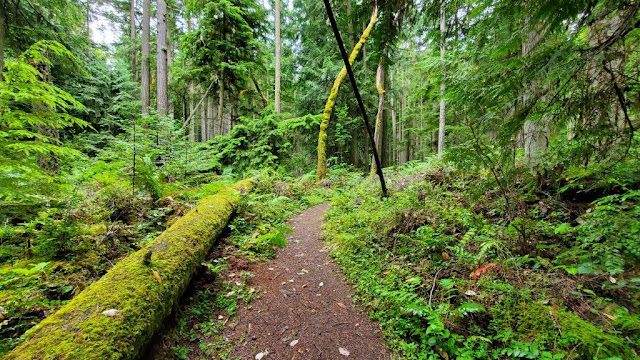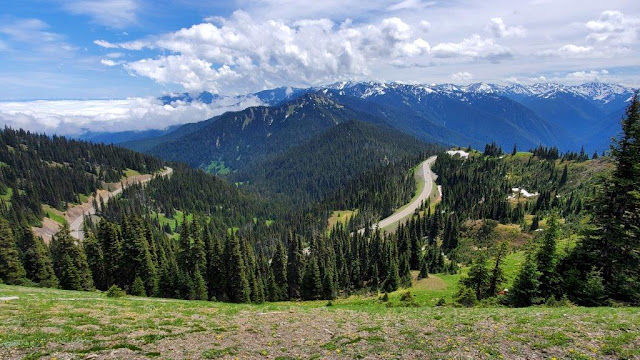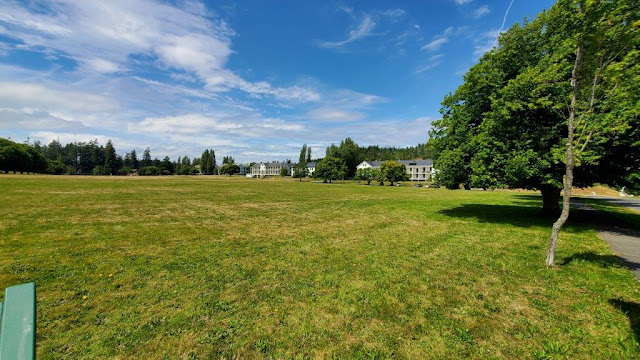We left Sequim and dumped our tanks at Fort Townsend SP. Then we drove to the Elks Lodge in Port Townsend and got set up. I expected the RV parking to be full but
there were a lot of empty sites for the July 4th holiday week.

I'm missing a photo of our campsite. 😞
This lodge had a fun 60’s/70’s Music Bingo. I learned something new about Al, he is
really good at song identification. The
DJ would play a bit of a song and we had to find the name of the song on our
bingo card. If we got 5 in a row on our
bingo card first, we would win. It was a
lot of fun but we didn’t win.
One day we took the free public transportation bus from the Elks Lodge in to Port Townsend to check it out. We also wanted to see Port Townsend from the water so we signed
up for a Port Townsend Bay Tour provided by the Maritime Museum. It was their first trip of the season and it was not very organized.
We did saw some small porpoise, Port Townsend, a lighthouse, and a paper mill from the water.
 |
Point Wilson Lighthouse
|
 |
Port Townsend Paper Company, LLC produces Kraft pulp, paper, containerboard, and specialty products by blending virgin and recycled fibers at our mill headquarters in Port Townsend, Washington.
|
 |
Houses on the coast in Port Townsend
|
After the boat ride, we walked around town a bit before finding our way back to
the RV on the bus.

Check out the d
ecorations on this van.
 |
Some of us are here,
because we're not all there.
Port Townsend, Washington |
Another day we
did a nice hike from the Elks Lodge in to Fort Townsend State Park.
Built in 1856, Fort Townsend operated as a U.S. Army site on and off until a fire destroyed its barracks in 1895.  |
| The Banana slug is yellow and the second largest species of its kind in
the world (growing to almost 10") behind a European species (growing to
12"). |
We got up early (6:30) to drive to Olympic
National Park's Hurricane Ridge section to do the Hurricane Hill hike before it
got too crowded. We found a great
parking spot for our truck and did the hike on a beautiful day! We saw deer and marmot.
The 1.6 mile trail to Hurricane Hill ascends gradually at
first, then climbs more steeply through sub-alpine meadows.
From the top there are views of the Olympic
Mountains to the south, and Vancouver Island, British Columbia, to the
north.
Elevation gain:
650 feet.
 |
The remains of a snowman
|
 |
Mt Angeles at 6,454' in the foreground and
Mt Baker far off in the distance at 10,781'
|
 |
Mt Baker
|
 |
Unicorn Peak on the left and Unicorn Horn on the right
Victoria and British Columbia in the background |
 |
| Mt Olympus at 7,980' |
 |
Hurricane Ridge Visitor Center to the right of the snow in the middle of the foreground range.
|
 |
| Marmot |
After the hike we visited the Hurricane Ridge and Olympic NP
Visitor’s centers. We did a
couple more short hikes from the Hurricane Ridge Visitor’s center.
After leaving the park
we stopped off in Sequim for more diesel at $6.19 a gallon
at a Safeway. We had a great day at the Hurricane Ridge section of Olympic National Park!One day we took the free bus to Port Townsend again and walked around after finding the post office to pick up our mail that was sent as General Delivery.
 |
Pretty government building
|
 |
Someone's house
|
We then got back
on the bus to Fort Warden to walk around and see the lighthouse.
We didn't realize how much more there was to see! It was nice to see the soldier barracks and
officer’s homes and the parade grounds.
Prior to World War II, most of Fort Warden's soldiers called
the wooden barracks buildings "home."
Four of these building were built from the same blueprint and, while far
from post, could comfortably house as many as 109 men. Within the barracks, enlisted men ate, slept
and relaxed in shared quarters. Only
senior non-commissioned officers were given their own rooms.
Permanent barracks were self-contained units, often with
their own cooks, barbers and tailors.
Among a barracks building's more popular features was the day room - a
shared space with a pool table, several shelves of books and a radio.
Today, Washington State Parks has renovated the barracks for
use as conference facilities.
 |
Officers Housing
|
Team-Building for Troops
Each morning, Fort Worden's soldiers gathered on the parade
ground to receive their orders for the day.
Often the commanding officers inspected the troops at these gatherings
ensuring that the high standards of the armed forces were met.

 |
| The commander of the U>S Expeditionary
Force in World War I, General John Pershing, reviewed the troops on this parade
ground in 1920. |
Fort Warden's soldiers were expected to work well
together. Whether manning the cannon or
engaging in the upkeep of the fort, their tasks required close coordination and
teamwork. Many modern activities on the
parade ground still emphasize coordination and teamwork but leave plenty of
room for creativity and fun.


 |
Looking from the Officers Housing over the parade grounds to the barracks
|
 |
Port Townsend Marine Science Center in Fort Warden
|
Battery Kinzie was the last fortification built in the Puget
Sound defenses prior to World War II. It
was also the most powerful, mounting two 12-inch cannons on modern versions of
the disappearing carriage. Construction
began in 1908, some 10 years after the building of heavy gun batteries on the
high ground above the Point Wilson sand spit.
Battery Kinzie was intended to solve several weaknesses in the original
fortification plan. It added two 12-inch
guns to the modest number of four already in the defenses. It was located where it could protect the
entire entrance of Admiralty Inlet from shore to shore. Its beachside position allowed it to cover
the waterway below the fog that often lay just above the surface of the water.
Named after Brigadier General David Hunter Kinzie, veteran of the Civil War (commander, Battery K, 5th U.S. Artillery at the Battle of Gettysburg), who died in 1904.

 |
Battery Vicars, secondary battery to Kinzie at Fort Warden
|
 |
| Placing Battery Kinzie near the northern edge of the Point
Wilson shoreline enabled it to fire west into the Strait of Juan de Fuca. It also makes the giant structure vulnerable
to coastal erosion as the sandy point continues to evolve. |
 |
View of the beach and water from the battery
|
 |
| To load, aim, and fire the gun required a crew of 51
men. Each gun and its carriage weighed
more than 300 tons and could fire a half-ton, armor-piercing projectile almost
eight miles. |
On a down day, Al inquired about volunteering at the Elks Lodge. They asked him to mow some of the Lodge’s lawn on a riding mower. The grass was rather high. He'd never used a riding mower before so it was fun for him. Later we went to their fish fry and the Elks comped
our meal for Al’s mowing. The fish
dinner was 3 pieces of fish, 5 fried shrimp, fries, coleslaw, sauces for $19
and it was delicious.
 |
Looks so much better!
|
Here is the area on the Olympic Peninsula covered in this blog entry.
Next we're going south and around Seattle then north of Seattle towards the Canadian border. Thanks for following along.
BTW,
if you leave a comment, please include your name or initials so I know
who wrote it. Most comments are from Anonymous and I would love to know who wrote them.






















































































































































Lots of history and stunning photos!
ReplyDelete